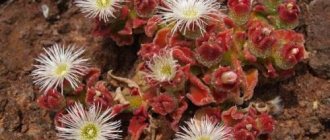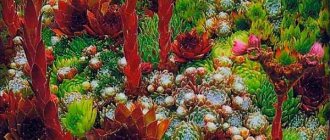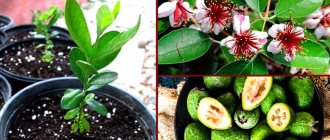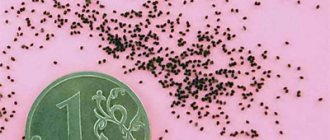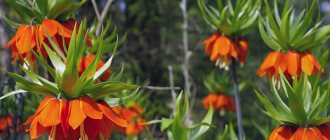One of the most beautiful and original flowers not only in the indoor kingdom, but also in the garden can be safely called cyclamen, which amazes with the riot of colors in the shades of its inflorescences. It is in this plant that you can easily find all kinds of variations of pink - raspberry, purple, as well as soft pink, pastel. More saturated shades - red and burgundy, as well as purple and blue, especially stand out against the contrasting greenery. And the chain of magnificent shades is completed by snow-white, which masterfully emphasizes the grace and beauty of cyclamen.
The shapes of the inflorescences themselves are unusual and very attractive, because they have external similarities with multi-colored butterflies, where the sharp leaves are often slightly bent back. The leaves are large and small, very delicate and fragile, round in shape, dark green in color, with pronounced whitish circles-stains throughout the leaf plate. It is very strange to see this multi-colored, blooming and faintly fragrant palette created from plants with the beautiful name “Cyclamen” in the garden plot. Yes, yes, this is exactly the cyclamen that we are used to seeing on the windowsills of houses, or rather one of its types. Today, more than four dozen varieties of this beautiful flower are known. And not every variety can be found growing in the open ground at the dacha.
Cyclamen: description of the flower
Cyclamen is a perennial tuberous plant that belongs to the Primrose family (subfamily Myrsinaceae). In the wild, the flowering plant is common in southern Europe, on the coasts of the Mediterranean and Black Seas, and can also be found in the Caucasus. There are more than 60 species of wild cyclamen, and only about 20 of them are grown as indoor crops.
The name of the flower “cyclamen” comes from the Greek “kyklas”, which means “round”. This is due to the shape of the plant’s tubers, which have a round, slightly flat shape. The diameter of the tuber reaches 15 cm. The flower itself in its structure resembles bright fluttering butterflies, towering above rich green leaves, on thin but strong peduncles. The color range of cyclamens is admirable. Delicate butterfly flowers can be bright pink, soft purple, lilac, snow-white, burgundy or purple. The height of the peduncle is up to 30 cm; there are dwarf varieties reaching no more than 12 cm in height.
The heart-shaped leaves collected in a rosette give the plant a special charm and decorative appearance. The leaves are painted a rich green color; sometimes there are specimens with silver streaks. In addition to its decorative qualities, cyclamen is a useful medicinal plant. Cyclamen drops are an effective remedy for the treatment of sinusitis and other diseases of the nasal cavity.
Transfer
First of all, you need to prepare fresh soil or purchase ready-made soil in the store. This has already been written above. The soil must be air and water permeable.
It is necessary to replant the crop together with a lump of earth. If it is a Persian species, then a third of the tuber must be left above the surface of the soil, if it is European, then the tuber is completely buried in the soil.
Rotten and damaged roots should be removed if possible.
You need to decide which pot to choose for transplanting. The container is taken a little wider than before, but it should not be too spacious. For tubers aged about 3 years, take a pot with a diameter of no more than 15 cm.
Transplantation is usually carried out at the end of the dormant period.
After transplanting, you need to water carefully; it is better to water from a tray. Fertilizing is required only three weeks after transplantation.
Popular varieties of cyclamen
Among the most common varieties grown in our latitudes are Persian cyclamen or drevka and European cyclamen (alpine violet). There are both tall varieties of the plant and dwarf species of cyclamen.
- Persian cyclamen. The flower's homeland is Mediterranean countries. The height of the plant is about 30 cm. The leaves of the plant come in a wide variety of shades. There are cyclamen with white, pink, lilac flowers. The variety has a pleasant aroma.
- European cyclamen. Distributed on the Crimean coast and southern Europe. The flowers are small, painted in a delicate lilac color.
Cyclamen: growing in open ground
Having decided to plant cyclamen in the garden, it is worth considering that this exotic flower is poisonous. Cyclamen is harmless to humans, but poses a threat to domestic animals that may eat the plant. The exception is pigs, who simply adore the juicy and appetizing cyclamen tubers. For this unusual feature, the flowers are called “pork bread”. Therefore, you should not plant cyclamen tubers near agricultural buildings where poultry or rabbits move freely.
Choosing a permanent place in the garden for cyclamens
Cyclamen are light-loving plants, but they feel best in partial shade, under the lacy crowns of deciduous fruit trees. Exquisite cyclamens get along well under spreading pear, plum, and apple trees. The flower develops well on rocky alpine hills, at the foot of tall evergreen bushes. The exotic beauty should be protected from draft winds and scorching sun rays.
Soil for planting cyclamen
The perennial is picky about soil; to plant tubers it is necessary to use a prepared soil mixture. The ideal soil composition for cyclamens should consist of turf and leaf soil (in equal proportions) and small crushed stone, which will create a drainage layer. Providing good drainage is an important rule for growing demanding cyclamens. This is a moisture-loving crop, but does not tolerate excessive humidity, which causes the root of the flower to rot.
Learn more about watering in the video
Features of caring for different types
Today, mini cyclamens have become extremely popular among gardeners. This is not a separate species. Mini cyclamen is a miniature copy of other species. On sale you can find mini cyclamen mix, Snow Hill, Bridget and other varieties. The height of these crops does not exceed 15 cm.
Mini cyclamen
The “Snow Hill” variety is distinguished by long and abundant flowering. It begins to bloom in November and ends at the end of April. Prefers partial shade. It is necessary to water during flowering so that the soil always remains moist. During the rest of the flowering period, the top layer of soil should dry out between waterings.
Neapolitan or ivy-leaved cyclamen blooms in autumn. What makes it special is that the flowers form before the leaves. The ivy-leaved species prefers a light, slightly alkaline or neutral substrate. A good drainage layer is required, since the slightest excess of moisture can cause rotting of the root system.
Neapolitan cyclamen is best planted where direct sunlight does not penetrate. Since their contact is dangerous due to the appearance of brown stains.
Small-flowered cyclamen have a less attractive appearance, but with more careful care they are not inferior to large-flowered varieties due to the abundance of flowers and general elegance of appearance.
Small-flowered
How to plant cyclamen in open ground?
When planting cyclamen tubers in the ground, the following planting rules should be taken into account:
- The tubers of the plant are placed in a hole with a pre-prepared soil mixture, deepening them 10 cm into the soil. This is the optimal planting depth for cyclamen, which will not allow the flower to freeze in winter.
- When planting a tuber, special care should be taken not to damage it. The cyclamen tuber has only one growing point. A damaged tuber will not grow and the plant will die.
- When planting, it is worth considering that cyclamen grow excellently in a well-chosen permanent place for up to 10 years. Frequent replanting is unfavorable for the plant, as it weakens its root system.
What to do after purchase
You can often hear questions: “I bought a flowering cyclamen, when should I replant it?”
It is recommended to replant a purchased flower:
- Immediately after purchase:
- At the end of the rest period.
After purchasing plants with buds and flowers in a store, you cannot immediately replant them . It is worth waiting for the end of flowering. Otherwise, the flower may die.
If a decision was made to replant the flower after the dormant period ends, then this must be done before the formation of buds begins.
Freshly purchased cyclamen should not be watered too much or placed in direct sunlight. This will damage the plant.
Consultation from a specialist at the Yegoryevsk Greenhouse Plant. Intelligible and clear.
How to propagate cyclamen?
Persian cyclamen is propagated only by seed, while the European variety can be propagated both by seeds and by dividing the tuber. Cyclamen seeds of various colors can be bought at any flower shop or ordered online.
How to grow cyclamen from seeds?
- The seeds are sown in February. Small containers filled with universal soil are used.
- Before planting seeds, the soil must be well moistened.
- The seed planting depth is at least 1 cm.
- Sowing needs regular moistening; the temperature in the room should not exceed 18 degrees.
- The first shoots appear a month after planting the seeds.
- When the first two leaves appear, the seedlings can be picked and transplanted into pots. Cyclamen is planted in a permanent place in the last days of spring. It should be noted that cyclamen will begin to bloom in open ground only in the second year of life, until the tuber gains strength for flowering.
Propagation by tubers involves carefully separating the side tubers that form the mother tuber.
Cyclamen in open ground: care
Caring for an exquisite flower consists of regular, sufficient watering, fertilizing and removing faded inflorescences.
- When watering the plant, do not allow moisture to get inside the rosettes of tender leaves. Stagnation of water in the rosette of leaves can lead to their rotting. When the flowers fade, they should be removed. Dried leaves must also be removed, which must be carefully “unscrewed”, trying not to damage the root rosette of the plant.
- As for cyclamen fertilizer, after a month the flower must be fed with liquid fertilizer for flowering plants. Cyclamen needs a second feeding after another month.
- Cyclamen does not tolerate winters well without reliable shelter, so to protect the tender tubers from freezing, use a shelter. A good layer of dry foliage is suitable as protection from frost, which will maintain an optimal level of moisture in the soil and provide nutrition to the tubers.
Problems and difficulties
Owners of this culture often have to face many problems. This is not only a refusal to bloom, but also early death of the flower, yellowing and wilting of leaves, as well as diseases and pests.
Why does cyclamen die?
You can often find the following questions on forums: “I bought cyclamen, but it began to die. What to do?"
The reasons can be very different:
- Overwatering or lack of watering;
- Poor quality soil;
- Exposure to direct sunlight. After purchase, you cannot expose the flower to the sun;
- Drafts;
- Too cool or too hot air;
- Poor root system.
If the flower was purchased during the budding or flowering phase, you must wait until the end of flowering without replanting it in another soil. Replanting will be required in the fall. If the plant begins to die, then it is necessary to inspect its tubers. If there are damaged or rotten roots, they need to be removed and the crop replanted in new soil.
Also, when purchasing, you need to pay attention to the type of cyclamen. So, the European one does not have a rest period, it simply stops growth for a while .
If the leaves turn yellow
Why do the leaves turn yellow and wither? This is especially unpleasant during flowering. The cause of yellowing leaves is improper care of the crop.
Firstly, it is recommended to pay attention to the plant and its tuber when purchasing. The tuber must be smooth, intact and not affected by rot. And the leaves should have a lush green color and a fresh appearance.
It is best to purchase a plant in the fall, when buds or even flowers have already appeared on it.
Causes of yellowing leaves:
- The indoor air is too dry;
- The air temperature is too high;
- Lack of moisture;
- Direct sunlight on the leaves.
To avoid yellowing of the foliage, it is necessary to create the most comfortable living conditions: increase the air humidity (ventilate the room, but without drafts, place a container of water nearby, fill the tray with wet pebbles, use special humidifiers), set the optimal temperature to about 18 degrees, water the plant on time, avoiding overwatering and drying out, protect the plant from bright sun.
Diseases and pests
Among the pests we should highlight:
- Thrips;
- Cyclomene mites;
- Shield.
Thrips are pests, their length does not exceed 1.5 mm. They affect the leaves, stems and even flowers of the plant. Then they go into the ground. The mature larvae develop wings and are released from the soil.
The presence of thrips can be determined by light-colored spots and dots. And the platinum sheet itself has a silvery sheen. In addition, curling of the leaves is likely.
You can treat the flower with a soap solution and insecticidal preparations (Aktara, Actellik and others).
The cyclomene mite is the most common pest. Differs in extremely small sizes. Lives on the underside of leaves. It causes not only deformation and curling of leaves, but also wilting of buds and the formation of irregularly shaped flowers. The growth of cyclamen also slows down.
It is treated with insecticides (Aktara, Fufanon and others).
Scale insects can be identified by the presence of brown spots on the leaves and stems. You can fight it with a soap solution and insecticides.
Diseases:
Gray rot is a fungal disease that affects the entire crop and can lead to its death. Identified by a gray coating and softening of damaged areas. It is required to treat at the first signs with fungicides, and also transplant the plant into a new permeable substrate;
Rhizoctonia rot is another fungal infection that can destroy a flower in the shortest possible time. It can be detected by soft spots on leaves, stems, and tubers. The reason is waterlogging due to too high temperatures. Treated by treating with fungicides and stopping watering;
Late blight is a fungal disease. Identified by the gradual drying out of leaves and flowers. Subsequently, if not treated, the entire plant will die. The reason is excessive soil moisture. Treated with fungicides.
Cyclamen pests
One of the common enemies of cyclamen grown in open ground is the cyclamen mite, which feeds on the succulent leaves of the flower. To combat the pest, a solution of insecticidal soap is used, which is used to wipe the leaves of the plant. For preventive purposes, the leaves are sprayed with Agravertine.
Cyclamen is an amazing flower that attracts attention. Blooming colorful cyclamens, reminiscent of carefree fluttering moths in pink, lilac or purple, seem like a real miracle in the garden.




